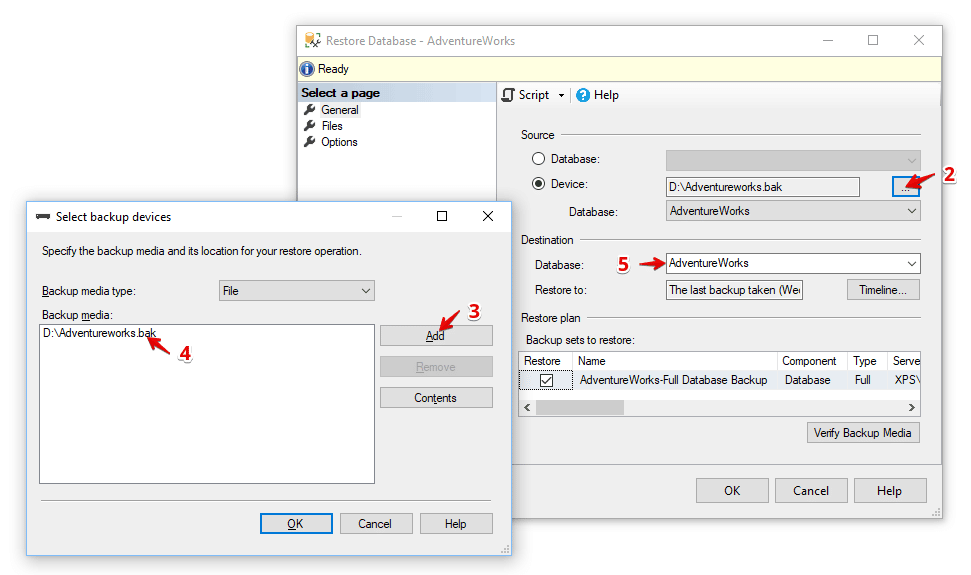
- #ADVENTURE WORKS 2017 FULL DATABASE BACKUP.ZIP INSTALL#
- #ADVENTURE WORKS 2017 FULL DATABASE BACKUP.ZIP ZIP FILE#
So, what will you do with this new power? Here you can see a set of examples I wrote for creating a vSphere Change Management Database:Įven if you aren’t working with anything to do with VMware, downloading the vSphereCMDB script will give you more examples to work from so I definitely recommend it.
#ADVENTURE WORKS 2017 FULL DATABASE BACKUP.ZIP ZIP FILE#
You can download all the examples in the zip file below: Pre-Requisites: Adventure Works 2014 Full Database Adventure Works for SQL Server 2012 (Database Engine) Download OLTP Database AdventureWorks2012 Data File (Restore using Database Attach method) Restore using Backup & Restore Method: AdventureWorks2012-Full Database Backup.zip. $SQLQuery5Output = Invoke-Sqlcmd -query $SQLQuery5 -ServerInstance $SQLInstance -Username $SQLUsername -Password $SQLPasswordĪnd that’s it! With these simple example, the world of SQL is now within the grasp of your PowerShell scripts. # Setting the values as variables first, also converting to correct format to match SQL DB

$SQLQuery1OutputCustomer = $SQLQuery1Output | Where-Object " -f (Get-Date) $SQLQuery1OutputTop100List = $SQLQuery1Output | select -first 100 $SQLQuery1Output = Invoke-Sqlcmd -query $SQLQuery1 -ServerInstance $SQLInstance -Username $SQLUsername -Password $SQLPassword # Example of SQL Select query to pull data from a specific database table # Example of SELECT to pull data from a SQL table With the SqlServer module imported and required variables set, let’s run a SELECT query to pull data into PowerShell and assign it to a variable: # The “.\InstanceName” connects to a local SQL instance for testing and I’m using the sa account to authenticate: $SQLInstance = ".\SQLEXPRESS" We can now specify the variables required to connect to the local or remote SQL instance/database desired. Install-Module -Name SqlServer –Scope AllUsers -Confirm:$false -AllowClobber # Installing module, requires run as admin for -scope AllUsers, change to CurrentUser if not possible Set-PSRepository -Name PSGallery -InstallationPolicy Trusted
#ADVENTURE WORKS 2017 FULL DATABASE BACKUP.ZIP INSTALL#
# Not installed, trusting PS Gallery to remove prompt on install Write-host "SqlServer Module Not Found - Installing"

$SQLModuleCheck = Get-Module -ListAvailable SqlServer # Checking to see if the SqlServer module is already installed, if not installing it If you’re not sure what version you are on type $PSVersionTable to see.Īll we need is internet access on the host running the script to install and import the SqlServer module: # I recommend using PowerShell 5.x onwards. In SQL 2014 it was a standalone installer, initially in 2016 builds it was bundled on the host, but it has since been moved into the online PowerShell Gallery. With a SQL instance installed and database to query let’s start by loading the SqlServer PowerShell module. Download it from here:Īdventure Works 2014 Full Database Backup.zip

To test you will first need a SQL database! I recommend not using something in production, better to download and install SQL Server Express 2014/2016 then restore the “Adventure Works 2014” database (which I will be using to demonstrate). If you’ve never connected to a SQL Instance using PowerShell before then I recommend reading this newer blog post here with pre-built examples:


 0 kommentar(er)
0 kommentar(er)
